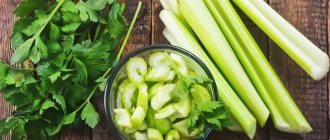Thanks to its magical aroma and beneficial substances, rosemary is used in cooking, folk medicine and home cosmetics. It adds piquancy to the taste, stimulates the immune system, and relieves inflammatory processes. This seasoning is not yet very popular in Russian cuisine, but housewives are increasingly thinking about how to prepare rosemary so that it does not lose its unique properties. After all, in winter, at home, having tried a tincture or an original dish, you will be able to remember pleasant summer days.
How to store rosemary at home
Dear hostesses, I store rosemary to add to dishes to give them a unique aroma. For different needs I store spices in different ways; look at the options with shelf life in the table.
| Rosemary | Storage method | Temperature (degrees) | Shelf life |
| Fresh | In a glass of water In the refrigerator | up to 25 0+3 | 5-7 days 7-10 days |
| Dried In tincture | Sealed container | +5 + 30 | 10-15 months |
| In oil In paste | Ziploc bag in freezer | -23 | up to 6 months |
| With salt | Container with a lid on a shelf in a closet | up to 25 | with fresh grass no more than 2 weeks, with dried grass - 6 months. |
Author's note
Natalia Papanova
Blog author
I add rosemary with salt and fresh to marinades to add flavor and remove odor to game meat, rabbit, lamb and pork. I brew the dried one for medicinal and cosmetic purposes, and use the paste for sauces.
If you don’t like any of the proposed options, try growing rosemary in your apartment, so the storage problem will disappear by itself.
Fresh in the fridge
For short-term storage, I leave it in the refrigerator.
- I rinse under the tap to remove dust and insects.
- When the water has drained, I wrap the branches in a damp cloth.
- I put it in a container with a lid.
- I put it in the compartment on the refrigerator door.
- Once every 2 days I review the plant and moisten the fabric.
- This way the rosemary stays fresh for more than a week.
Watch a video story about the spice.
Dried
Friends, when I buy several bunches at once, I always leave one or two to dry. You can dry rosemary in the oven, in a special dryer, or simply in the air. I use a simple method, no cost.
Are you preparing dried rosemary for the winter?
Not really
Instructions
- I rinse under running water.
- I dry it on a towel.
- I collect 5-6 branches in bunches and hang them in a ventilated area.
- The main thing is that the sun does not fall on the rosemary.
- I pack the dried branches into fabric bags and store them in the pantry or closet until the next harvest.
- Taste and smell are preserved by 90%.
Keeps dry longer in a glass container with a lid
In sea salt
Dear housewives,
an excellent addition for pork, grilled chicken and roasted vegetables.
It can be done in advance or while preparing the dish.
Ingredients
- 200 g sea salt;
- 100 g chopped rosemary leaves;
- lemon zest - ½ pc.
Instructions
- I cut the zest into pieces.
- I mix the ingredients.
- I blend it into powder with a blender.
- I store it in a jar with a lid in the refrigerator for 2 weeks if I used fresh rosemary.
- If I mix it with dried, I leave the container on a shelf in the closet and it sits in a tightly closed jar for up to six months.
You can plant another fragrant herb yourself in pots next to rosemary! Hurry up and watch how to grow basil at home!
In a vacuum
Dear cooks, as I found out, the ideal
packaging is vacuum packaging.
It retains moisture as much as possible and does not allow air to pass through, which is important for the safety of the product.
- I put the washed and dried branches in a bag.
- I release the air with a special machine.
- I seal and store in the refrigerator for up to 12 months.
In tinctures
I prepare tinctures to add to sauces; the herb is stored well in an alcohol and vinegar solution.
Ingredients
- 3 sprigs of rosemary.
- 200 ml of alcohol or table vinegar 9%.
- Lime zest - 1 pc.
Instructions
- I cut the zest into strips.
- I put the whole zest and branches into a dark glass container.
- I fill it with alcohol and close it tightly.
- I put it on the shelf of the kitchen cabinet.
- After 2 weeks, the tincture is ready for use.
- It can be stored for up to 2 years without losing its properties, indoors in an airtight container.
Calorie content per 100 g: 841 Kcal.
At room temperature
Dear hostesses, the rosemary in the room stays fresh for no more than a day. To preserve it longer, I put the branches in a glass of water.
- I place the glass so that there is no direct sunlight.
- I put an activated carbon tablet in the water.
- I change the water in the glass once a day.
- This way the greens will remain fresh for up to a week.
In addition to rosemary, parsley is suitable, read about growing parsley on a windowsill to have fresh herbs growing in the house.
Factors affecting shelf life
The length of the shelf life will depend on whether all the storage conditions for the spice are met. First of all, the shelf life of rosemary depends on:
- In what form is the spice stored ? The shelf life of fresh rosemary is much shorter than dried rosemary.
- How high quality is the spice itself ? This is true for those cases when the grass is not grown with your own hands, but purchased from a store. When purchasing, it is important to pay attention to the appearance of the leaves - they should be green with a slight blue tinge, sit firmly on the stem, not fall off and have no rotten parts.
- If you buy rosemary in dry form, then its shelf life should be no more than six months from the date of packaging.
- If the herb is dried before storage, then an improper drying process can shorten the shelf life of the spice.
- Fresh rosemary will have a shorter shelf life at room temperature than if stored in the refrigerator.
- The best conditions for storing fresh herbs are air with high humidity and a temperature not exceeding 5 degrees .
How to Preserve Rosemary for the Winter
For long-term storage I make different mixtures of aromatic herbs. I experiment and find interesting combinations. I’ll tell you how to properly store fresh rosemary and oils for the winter.
Watch the video on how to make rosemary oil.
Freezing in oil
Friends, I keep the seasoning frozen, just fill it with oil. This way, the beneficial and taste qualities are preserved with virtually no loss.
Ingredients
- Olive oil - ⅓ cup.
- Chopped rosemary leaves - 2 cups.
Instructions
- I mix the ingredients.
- I put it in the compartments of the ice container.
- I put it in the freezer.
- I take out the cubes as needed and store the remaining ones for 5-6 months.
Calorie content per 100 g: 315 Kcal.
You can pour olive oil directly into the compartments
Have you learned how to freeze rosemary? Find out how to preserve sorrel for the winter so that the vitamin-rich vegetable is at hand at the right time.
Have you tried freezing rosemary and butter?
Not really
Storage in paste
Dear housewives, I am mixing spices for the winter that will harmonize perfectly with each other in dishes. I think the best option for long-term storage of rosemary is to prepare various pastes. I bring to your attention the recipes for the most organically combined mixtures.
Ingredients: option 1
- Olive oil - ½ cup.
- Rosemary leaves - 3 cups.
- Chopped ginger root - 2 tbsp. l.
- Ground garlic - 2 tbsp. l.
Ingredients: option 2
- Butter - 250 g.
- Lemon zest - 1 pc.
- Garlic - 5 cloves.
- Rosemary leaves - 5 tbsp. l.
Instructions
- I place each set of ingredients separately in a bowl.
- I grind it with a blender or twist it in a meat grinder.
- I put the resulting paste-like slurry into ice compartments and put it in the freezer overnight.
- In the morning I put the cubes in a container with a lid and put them back in the freezer.
- Or I immediately put them into ziplock bags, release the air and stack them on top of each other in the freezer.
- I take out the right amount to add to the dish and don’t freeze it a second time.
- The paste sits at a temperature of -23 degrees for six months.
Calorie content of pasta with olive oil per 100 g: 1015 Kcal.
With cream – 879 Kcal.
Rosemary varieties suitable for storage
There are several types of rosemary found in nature.
But only 2 of them are bred in gardening. Rosemary officinalis is found more often than others. Its straight stems are strewn with dense narrow leaves. This species is grown as a spice and used for treatment. Bushes are planted in gardens and grown on window sills in flower pots. Prostrate rosemary is a bush with a spreading, spherical crown. The shoots grow up to 70 cm in height and are highly branched. Its leaves are thin, like needles, changing shade from light green to bluish.
The following varieties are suitable for storage at home:
- Corsican Blue is a medicinal plant with a well-developed root system.
It has opposite leaves that are greyish-green in color. In late April or early May, small blue flowers bloom on the branches, forming paniculate inflorescences. - The Crimean variety is actively cultivated in the southern regions.
In open beds it grows as a shrub up to 1 m high with leathery, needle-like leaf blades of gray-green color. Harvesting of fragrant foliage and young shoots is carried out from the end of February. - The Tenderness variety has leaves in the form of thin needles up to 4 cm long.
With the onset of autumn, their shade changes from green to gray-blue. In the south it is grown in open beds. In the northern regions - exclusively as a houseplant. - The Rosinka variety is a medicinal crop.
Its low stems are densely covered with dark green linear-lanceolate leaves. They contain a high concentration of essential oils. - The White variety has medicinal properties.
It has bright green, needle-like leaves that are used to make a tonic tincture. The plant is distinguished by unusual white inflorescences. - The Ampelny variety has long shoots hanging down.
They are densely strewn with narrow leaves of bright green color. This variety is very sensitive to frost. Therefore, it is planted only in pots. - The Biryusa variety has glossy leaves with curved edges.
The plant blooms twice a year in March and September with small flowers in blue tones. The variety is very sensitive to low temperatures. That's why they plant it in tubs. - The Blue Winter variety has bluish-green, needle-shaped leaves.
The plant tolerates temperatures well down to -17°C, but in the middle zone it is grown at home.
Parsley and cilantro (coriander)
Parsley
What dishes does parsley go with?
Add parsley or cilantro to the finished dish to add bright flavor and color to the culinary creation. Mix finely chopped parsley (cilantro) with lemon juice and pour this mixture over rice, you will have a delicious side dish.
Place chopped parsley and cilantro in a container with vegetable oil, squeeze out a clove of garlic, add a couple of tablespoons of freshly squeezed lemon or orange sauce. This marinade is great for all types of meat, chicken and fish.
Cilantro (coriander)
How to store parsley and cilantro
Rinse and dry the parsley/cilantro. Wrap the greens in a water-soaked towel, then place them in a plastic bag. Store the bag in the refrigerator for 3 to 5 days.
Parsley or cilantro pesto sauce
Make pesto sauce from parsley or cilantro. It goes well with vegetables, seafood, pasta and meat. Mix a bunch of greens, a handful of walnuts in a blender, slowly pour in a little olive oil, add grated Parmesan, salt and pepper to taste. Store the sauce in an airtight container in the refrigerator.
Cold storage
If you want to keep rosemary fresh for a while without freezing, there is no need to wash the herb first. You will need a waffle towel, which you need to wet and wring out. Spice sprigs are wrapped in it, the towel should be packed in a plastic bag and placed in the refrigerator. You should periodically check to see if it has dried out.
A fresh rosemary bush in the refrigerator should be placed on the door where it is not too cold. In this case, the shelf life is extended to a month. Instead of a towel, some people prefer to use parchment paper dampened with a spray bottle. Everything else is done as in the first method. You can also store the plant in a vase or jar of water, like a bouquet of flowers. To do this, the ends of the branches need to be cut off. A bag is placed on top of the bun. The water will need to be changed every few days. Rosemary leaves should be carefully wiped with a towel so that there is no moisture on them. If the leaves have acquired a dark color, they can no longer be used.
Rosemary is useful - it boosts immunity, improves digestion and treats colds.
Storing in sea salt
Any dish will sparkle with new colors and acquire a unique taste if you add herbs to it. Did you know that handling greens requires remarkable culinary skill? Properly chopped and timely added dill or basil can radically change the taste of a gastronomic masterpiece. You should also not forget about the storage conditions for fragrant greens. You might find these helpful tips useful.
What dishes does basil go with?
Basil should not be cooked for long. The longer you cook it, the more it loses flavor. Fresh basil is the best company for sandwiches, salads, and sauces, provided that it is placed in a frying pan or pan no more than a minute before it is ready.
Try tossing basil with any store-bought pasta sauce. You will immediately feel the difference.
How to properly cut basil
Small leaves can be added to food in their original form. Large ones should be torn off, folded into a small pile, folded in half, and then cut into thin small strips. If you want to chop the herbs finely, simply roll the basil again and chop.
How to store fresh basil
Cut off the bottom of the stem and wipe the leaves dry. Fill a small container with water and place a bunch of greens in it. Take a plastic bag and make several holes in it to allow oxygen to penetrate. Place the bag over the container with the basil. Basil should not be placed in the refrigerator. It will feel quite comfortable on the kitchen table away from direct sunlight. Change the water daily and you can enjoy fresh basil for a week.
Rules for sowing rosemary at home on the windowsill
Girls and boys, now I’ll tell you how to sow correctly:
· Pour a drainage layer (5 cm) of perlite and expanded clay into a plastic container, add the prepared substrate, leaving 5 cm to the edge for watering and adding soil as the seedlings grow.
· Then place the container to warm up on the windowsill, unfold the material with the seeds and place it nearby to dry.
· When the substrate warms up in the sun, make holes up to 0.3-0.5 cm deep at a distance of 2-3 cm.
· Carefully place the seeds in each hole, moisten the soil with a spray bottle and add a little soil.
· Cover the container with plastic wrap, making several holes for ventilation.
· Place the container with future seedlings in a warm place (+25-30 degrees).
Preparing rosemary for winter
The onset of cold weather and freezing of the soil is an obstacle that can destroy an ornamental bush.
In order for rosemary to withstand unfavorable living conditions, it must be prepared for them, starting in spring:
- Close proximity to groundwater is dangerous for the plant. An evergreen perennial will be saved by good drainage, which will prevent the roots of the shrub from weakening and rotting.
- When flowering shoots grow on the site for more than one year, they need to be fed 1-2 times during the growing season. To do this, add up to 2 kilograms of humus or compost per square meter. After fertilizing, the soil is loosened to a depth of 5-10 centimeters.
- Mineral fertilizers also allow rosemary to strengthen before wintering. The complexes should contain potassium, nitrogen and phosphorus. These elements will strengthen the plant’s immunity and allow it to withstand the cold period.
- Pruning the bush during the active period of life will reduce the load on the plant and rejuvenate the crown. The cut branches have a place in the kitchen. They are added to various dishes and drinks.
- When the bush is still young, and the winter is expected to be harsh, it is better to replant the shoots in a pot and bring them indoors. The plant is well preserved at a temperature of 10 degrees Celsius.
Strong ornamental bushes with a stable immune system can survive the winter and produce new shoots in the spring.
Planting a plant
Its further development depends on how correctly the flower is planted. Errors at the planting stage lead to the fact that rosemary begins to wither and may die.
Requirements for soil and pot
The result of growing a plant depends on the correct choice of pot and soil. Rosemary root is very branched, and it needs a spacious container. The roots have a high need for oxygen, and therefore the pot material must be porous. It is best to give preference to clay. Covered pots should not be used. For a young plant, a pot with an average diameter of about 20 cm is suitable.
The plant requires special soil. You can buy a crushed lime-based substrate at a flower shop, but it is better to prepare the soil for rosemary yourself.
To do this, the following components are connected:
- leaf soil - 2 parts;
- turf soil from which all roots have been removed – 2 parts;
- humus – 1 part;
- coarse river sand – 1 part;
- peat – 1 part.
Before the plant is planted, the soil must be very well watered.
Collection of raw materials for long-term storage
A supply of rosemary in the kitchen will be useful for any housewife. This spice has wide culinary uses. Pairs best with meat dishes. It is recommended to consume fresh greens immediately after they have been picked. But, if you can’t use it in one go, you need to take care to extend the freshness of the product. In order for the product to be truly high-quality, you need to understand where, when to collect it and how to dry it.
Rosemary is harvested during its flowering period from July to August. By this time, the maximum amount of essential oils accumulates in it. The branches are cut on a sunny day.
You need to use a well-sharpened knife. Before storing, the harvested crop is sorted. Damaged or dried specimens are not suitable for this purpose. Leaves showing signs of disease are thrown away.
The leaves of the plant are of greatest value for cooking. The graceful tops of the branches are often used to decorate festive dishes at banquets.
Rosemary can be replaced with spices such as thyme or oregano.
Thyme and rosemary
How to properly cut thyme
Thyme and rosemary have a fairly hard stem, so they are not used for food. Pick off the leaves and chop them finely. Add rosemary and thyme at the very beginning of cooking to maximize the flavors. These herbs go well with beef, lamb, chicken and roasted vegetables.
How to Store Fresh Thyme and Rosemary
Wrap the washed and dried herbs in a damp paper towel, then place them in a plastic bag. Greens will keep wonderfully in the refrigerator for 3-5 days.
Aromatic salt from thyme and rosemary
Make flavored salt. Mix 1-2 tablespoons dried rosemary or thyme, 1 tablespoon lemon zest with 1/4 cup coarse salt.
Use the seasoning to cook meat, fish and vegetables.
What dishes does dill go with?
This is the most universal seasoning for any dish: scrambled eggs and first courses, fish and poultry. Lemon juice or sour cream with dill makes a delicious salad dressing. It’s rare that a sauce is complete without a couple of sprigs of dill.
How to store dill in the refrigerator
Store greens in the refrigerator, first placing them in a plastic bag or in a container of water. Dill will not lose freshness for 3-6 days.
Green dill oil
Make green butter. Finely chop the dill and mix it with softened butter, lightly salt. Wrap the butter in parchment paper or cling film. Store it in the refrigerator for 1-2 weeks.
Rosemary is a versatile spice that is used for cooking and medicinal purposes. The twigs, flowers and leaves of the plant are used for cooking meat, fish, seafood, and vegetables. The greens are characterized by a pine smell and a moderately pungent taste. The essential oils contained in rosemary allow it to be used for medicinal purposes by preparing decoctions and teas. Since greens cannot be stored fresh for a long time, let’s look at how to preserve rosemary without losing its beneficial substances.
Most housewives grow the plant on the windowsill. In this case, the greens are collected before flowering, since it is during this period that they contain the maximum amount of nutrients. For storage, choose the juiciest shoots, up to 20 cm long.
The inflorescences are used for teas and tinctures. After collection, they should be immediately sent to dry, otherwise they will wither and lose their aroma and beneficial properties.
When purchasing fresh spices, it is important to pay attention to its appearance. The leaves should have a slight bluish tint, and the leaves should adhere well to the branches. If the leaves are wilted or have black or yellowish spots, you should not buy them.
When purchasing dried spices, first of all pay attention to the expiration date. It is no more than 6 months from the date of packaging.
It is best to buy rosemary that is packaged in the summer.
The spice should not contain additional ingredients:
- salt;
- pepper;
- preservatives and other additives.
Basic care requirements
To get a lush, spicy-aromatic plant with beautiful and rich foliage, you need to follow agrotechnical growing rules.
Pot and soil
The plant has a fairly large root system, so to grow rosemary at home you need to buy a spacious clay or terracotta pot. To ensure good air exchange for the plant and prevent waterlogging of the soil, it is recommended to pour expanded clay or small pebbles at the bottom of the pot. The excess will flow into the pan, and the drainage will not allow the roots to come into contact with water.
The plant can be planted in purchased soil or prepared from an equal amount of leafy, turf soil with the addition of humus, peat and sand. Since the leaves of the plant are used as a seasoning, fertilizing with complex commercial fertilizers should be avoided. It is better to use natural, organic ones.
On a note! If rosemary is grown as an ornamental plant, it can be fed with complex mineral fertilizers. In winter, rosemary does not require fertilizing.
Lighting
The pot with the plant can be placed on the windowsill on the south or east side. On a hot afternoon, the foliage should be protected from sunlight. The room in which rosemary grows must be constantly ventilated. An influx of fresh air along with sufficient natural light will ensure good foliage growth.
For your information! Sharp changes in day and night temperatures can destroy a flower, so when growing on a balcony or loggia, in cold weather it is better to bring the pot into the house at night. This way the root system will not get stressed and the plant will develop well.
- Watering. Rosemary loves the golden mean - not dry, but not wet either. It is recommended to water moderately, without unnecessary fanaticism. The root system, being in too wet soil for a long time, rots, which leads to the death of the plant.
- Bloom. In order for the plant to become covered with flowers, it needs a short period of rest. At this time, the rosemary is transferred to a cool room, watered as needed, but do not pick off the foliage.
- Harvesting. To make the plant bush better, it is recommended to pinch the top. When the foliage reaches 15 cm in length, the rosemary is ready to cut.
- Wintering the plant. When kept in winter, the temperature should be reduced to +10-15 ºC. Water moderately, not allowing the top layer of soil to dry out.
For your information! If possible, you can arrange additional lighting with fluorescent lamps, so that the plant will not have a dormant period and even in winter it will be possible to harvest.
Rosemary with salt
Many people make rosemary salt.
For this, it is best to use coarse sea salt. In a cup with it you need to put a handful of fresh seasoning leaves and the zest from one lemon. The resulting mixture is crushed using a blender until a fine texture is obtained. When the salt turns green, stop grinding. Spread paper on a baking sheet, onto which salt is poured in a thin layer. Place the baking sheet in the oven over low heat for 20 minutes. To store salt, it is recommended to use a plastic food container with an airtight lid. Regular glass jars will also work. They need to be kept in a dark and dry place - a closet or pantry. This salt is used for grilling meat and poultry; you can season salads and hot dishes with it. If you mix a small amount of olive oil with rosemary salt, you get a natural scrub.











